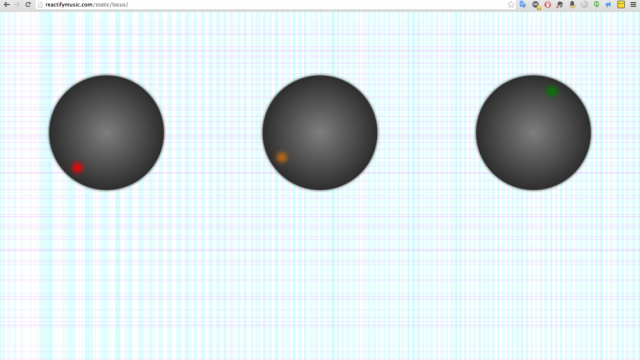NOTE: The demo is desktop Chrome and Firefox only, with the exception of the latest and greatest Sony Android phones.
Locus is a concept for a new way of creating and distributing an album, where songs are presented not as individual tracks, but as one continuous body of music, or as a multi-dimensional ‘music space’ that can be explored non-linearly.
Presented with a minimal interface of three parameters on the screen, the listener can change these parameters to change the characteristics of the music. This current demo contains three ‘tracks’, with ‘Speed’ (the far left circle) being the main differentiator between them. The other two circles control the ‘Intensity’ and ‘Spaciness’. Certain musical elements, such as the lead vocals, will only occur when the parameters are at the correct values. This means that ‘tracks’ can be though of as different configurations of the parameters’ values.
Why?
Mobile and browser technologies mean that there are many different ways for creating and distributing music, these days. This concept is an exploration of this fact, combining generative, reactive, and interactive music techniques to create an album that doesn’t have a set path or length, but can still be considered a complete body of work.
How?
The music has been composed with a mixture of traditional DAWs and Pd (Pure Data). Certain elements of the music, such as the drums and vocals, are sample-based, whereas the bass, synths and effects are all be generated in-browser. This also allows a great degree of flexibility with the melodies and chords being generated in realtime.
The Pure Data patch is then compiled using a Pd-to-C compiler, Heavy, which then converts the C to JavaScript using Emscripten, allowing us to run it in the browser with the WebAudio API.
This demo was developed at Sónar Barcelona Music Hack Day 2015, with Paul Adenot behind the WebGL graphics and WebAudio API debugging.
Taking the concept further
This initial demo shows the concept of an album without discrete borders between tracks. Future concepts we would like to explore include:
- Auto-play
- If left untouched, the parameters would start to manipulate themselves to move through the songs like a traditional album would, making the interaction entirely optional
- Parameter lock
- When in auto-play mode, the listener could lock certain parameters to given values. For example, locking the Intensity parameter to zero would mean that the album plays back in its entirety, but in an ambient way
- Other parameters
- This demo only features ‘Speed’, ‘Intensity’, and ‘Space’, but the parameters exposed to the listener are completely open to the producer’s imagination. They don’t need to be continuous parameters either. Buttons such as ‘Drop’ (which only becomes active when other conditions are met, as per our generative dubstep machine, Anita’s Dropship), would allow one-off events to happen, for example. Practical descriptors such as ‘Tension’, ‘Tonality’, and ‘Complexity’, as well as abstract ones like ‘Mystery’ and ‘Temperature’ are all ripe for exploration.
- DJ-friendly tracks
- Producers could music in this format that is intended for DJing. This means that DJs can dial in the perfect amount of Intensity, ‘Spaciness’, or any other parameter that the producer offers control over, and actually determine exactly how the music develops over time. If a DJ had an entire library of tracks in this format, he or she could actually start thinking in terms of detailed sonic characteristics rather than in the predetermined timelines tracks
- Reactivity
- Once composed in this format, it is only a short step towards making the parameters react to the listener’s environment. Intensity could be linked to whether the listener is still, walking or running, for example.
- A growing album
- Because this music lives on the web rather than being a downloadable artefact, an artist could continue to add music to it at any point. This could be interesting for doing a staged release of an entire album’s worth of music. Theoretically, an artist could even compose an entire life’s work of music to fit into this ‘music space’.

